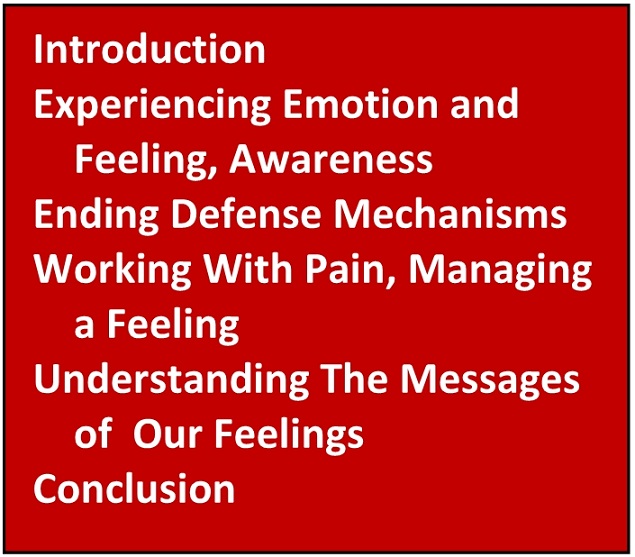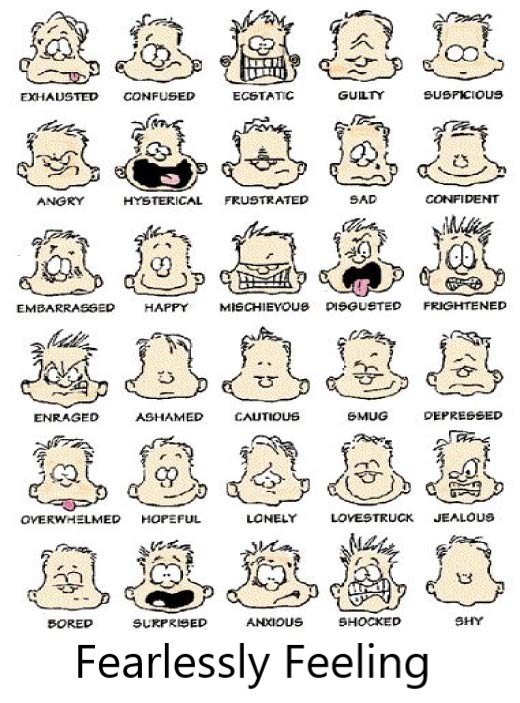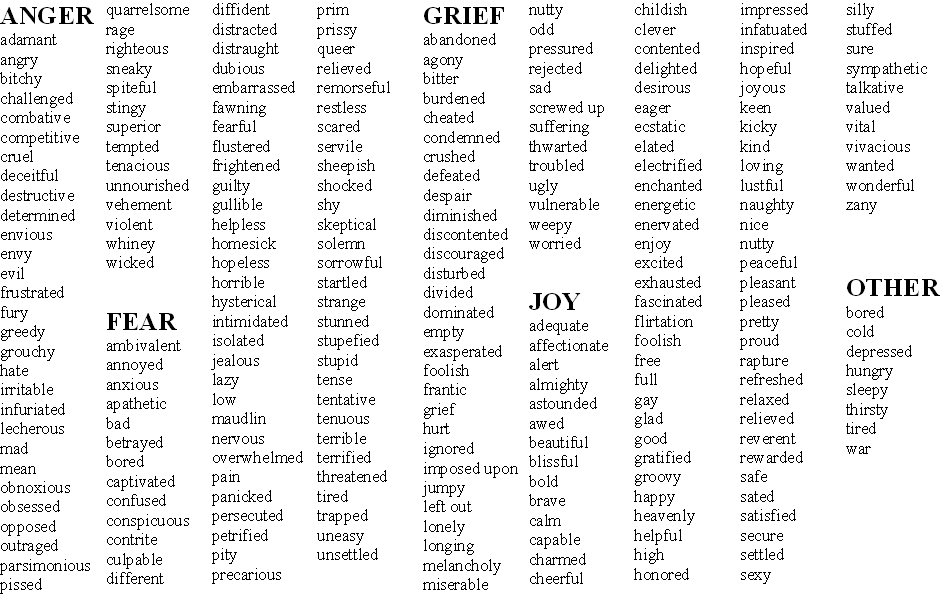Emotions And Feelings (IV): Techniques For Working With Our Emotions And Feelings Part (I)
INTRODUCTION
We have made a good start toward working effectively with our emotions and feelings by developing some understanding of how they function—what they do and the role they play in our lives. (See the Letters for April, June, and August 2020.) Now, we want to correct any distortions that exit in their functioning and explore getting the messages of our feelings. Let’s keep in mind the foundational ideas that emotion is a combination of both feeling and thought and that our feelings are literally our experience of life.
Point of Empowerment: In order to reach the goal of fulfilling our human potential we need to master the skills of dealing effectively with our emotions and feelings.
EXPERIENCING EMOTION AND FEELING
Experiencing our emotions is essentially feeling our feelings with awareness. We can also become aware of the thought that accompanies a feeling but in experiencing this is secondary to feeling the feeling. Our ordinary awareness is usually unfocused as feelings and thoughts fly by. We can slow feeling and thinking down by focusing on them. Our body is biologically designed to feel. We cannot not feel, though we can block awareness of what we feel with what are called defense mechanisms. Since experiencing our emotions and feelings begins with awareness we do not want to block our awareness. Here are some reasons why we might block our awareness of feelings.
- Fear of feelings. We have “unacceptable” feelings that we feel guilty about and judge ourselves for. When we were growing up, most people have heard some variation on this message, “Good people don’t feel that way.” Since we want to be a good person, we block the feelings we judge as unacceptable.
- Mistrusting feelings. We fear that our feelings will lead us into destructive places.
- Fear of painful feelings that we won’t be able to handle and fear that they will never end.
- Fear of the painful feelings that exist just below our awareness. This is a legitimate concern as there is usually a level of our pain that we have been ignoring.
- Fear of impulsiveness. We may think that we will have to act on a feeling if we are aware of it. We have acted impulsively on feelings that have gotten us in trouble and we therefore fear our impulsiveness.
- Fear of the unconscious. We have repressed out feelings, hid them in our unconscious. (“Out of sight, out of mind” or “What we don’t know can’t hurt us.”) Our fear is that if we feel our feelings our unconscious will erupt and overwhelm us with painful feelings. This will not happen.
Point of Empowerment: Removing blockages to our awareness of feeling requires understanding how emotions and feelings work, eliminating the use of defense mechanisms, learning to tolerate discomfort and pain, having courage and a sense of adventure, and desiring pleasure.
Let’s consider defense mechanisms. When we use them we start with the primary defense mechanism of denial, pretending that a feeling does not exist. Denial is often followed by a secondary defense mechanism like projection, displacement, suppression/repression, numbing, rationalization, minimizing, blaming, or substitution. Detecting a defense mechanism can be very challenging because with them we are blinding ourself. But we can start with recognizing a feeling of fear and/or anxiety. We can also look to how other people are reacting to us because they do not react positively when we employ a defense mechanism. They feel attacked, criticized, or blamed in some way, which is often the way we feel. How can we become aware of something we do not see? How can we end our blindness? We can:
- Fundamentally acknowledge and accept that we can be blind. State the affirmation, “I want to see what I am currently blind to.” Allow your vision to clarify. It will come to you.
- Tune into your moment to moment feeling of pain and pleasure, of anxiety and fear.
- Notice feeling attacked and a feeling of defensiveness—a need to protect yourself. Notice how you respond to those feelings. Then ask, “Where did that feeling go?” and “What am I feeling now?”
- Identify repeating “failures” that indicate that we are missing something.
- Identify repeating conflicts that you are having with others and what feelings are involved.
- Identify where you might have more pleasure, pleasurable feelings that you might be defending against.
- Use your courage to notice how the people in your life are reacting to you as you are using your defense mechanism.
Point of Empowerment: There are consequences to our blindness. Be open to seeing what the consequences are and to the feedback of those consequences.
Practice: Track your moment to moment feeling by stating, “Now I am feeling . . .” and state the feeling.
To end the fear that blocks awareness remember:
- That feelings follow a cycle. They emerge spontaneously, increase in intensity, peak, and diminish completing the cycle. This is the way feelings as energy work. No need for the fear that a painful feeling will never go away.
- Knowing that you will process your feelings and not impulsively act on them helps create trust and reduces the fear of impulsiveness.
- Be able to delay acting on a feeling until you choose to. This is taking deliberate action. At the same time realize that there is room for spontaneous action and the mistakes we sometimes make by acting spontaneously.
- As we focus on feelings that are currently out of awareness we will become aware of painful feelings. However, the amount of painful feeling is limited and gets reduced as we work with them.
WORKING WITH A PAINFUL FEELING
Painful feelings are unwanted feelings but they are invaluable. We could not survive without painful feelings that alert us to danger, tell us what we don’t want, and what we should avoid. However, repeating painful feelings when there is no danger and overly intense painful feelings, are unnecessary and cause unnecessary suffering. Working with a painful feeling involves short term and long term strategies. Short term is managing the feeling. Long term is reducing the frequency and intensity of the feeling and maybe completely eliminating it.
MANAGING A FEELING
To effectively cope with an overwhelmingly painful feeling it when it arises you can use the following strategy.
- Become aware that you are feeling pain, which includes being able to tolerate the presence of the feeling.
- Be able to tolerate the presence of a feeling by overcoming any fear of feeling the feeling. Be OK with the presence of the feeling by understanding that we have no direct control over it and that our job is to respond to a feeling. Accept the feeling by relaxing into it.
- To relax into a feeling focus on your breathe and relax your body. Learn and practice the skills of focusing your attention and relaxing your body.
- If the feeling continues to feel overwhelming you can distract yourself by focusing on something else, like exercising or playing a video game for example.
One aspect of permanently reducing a feeling is to get the message of the feeling and make the kind of change in your life that the feeling is directing you toward.
UNDERSTANDING THE MESSAGES OF OUR FEELINGS
Feelings contain general messages but are experienced in specific situations. To get the messages of our feelings we identify what we are feeling, identify the situation triggering the feeling, and understand why we feel that way. We then interpret the message. We are not immediately concerned with doing something about the situation. After getting the message we can change something if we want to.
To identify what you feel start with making the simple statement, “I feel. . .” and fill in the feeling. If you are not clear about what you feel just say something and continue filling in the blank until you sense that you have identified your feeling correctly. Concerning the situation, you will usually know the situation you are dealing with by either being in it or later reflecting on a situation that bothers you. Review the details of the situation and the feeling. To determine the message, make the statement, “This feeling is telling me that I. . . “ and fill in the blank. Here are some examples of feelings, general messages, situations, specific messages, and possible steps to take that honor and respect your feelings.
- Joy—this situation brings me joy. For example, playing with my grandson brings me joy. If I choose I can do this more often to bring more joy into my life.
- Happy—this situation brings me happiness. For example, sitting by a fire drinking tea brings me happiness. If I choose I can do this more often to bring more happiness into my life.
- Sad—this situation brings me sadness. My friend died and I feel tremendous sadness. I am in a mourning process that will take time. I know that my sadness is part of this process and will rise and fall, come and go as I mourn.
- Anger—this situation brings me anger. My boss repeatedly told me to do something unreasonable that is not part of my job description. If possible I can speak to him/her about this situation.
- Frustration—I am not getting what I want. I will start by clarifying what I want and figure out how to get it. I felt frustrated when I was sick and could not go out. I will take better care of my health.
- Pleasure—this feels good. I want more of this. Resting deeply after a busy day is pleasurable. I will make sure I give this gift to myself.
- Pain—this feels bad and I want less of this. What is causing me this pain? What can I do to alleviate this pain? I feel hurt by a past betrayal. I will feel all the feelings, let them go, and work toward forgiveness.
- Hunger—I need to eat something. But if this is actually an emotional hunger I look for what is missing in my life. I will identify the thing that is missing that gives rise to the impulse to eat and seek to add what is missing. My friend repeatedly cancels our dates. I value my time with my friend, will reschedule the date, and possibly seek new friendships.
- Longing—there is something missing in my life that I need to find. I will seek to add what is missing. A loving relationship is missing in my life. I will try to find one.
- Anxious—something that I am not aware of is causing me fear or pain. I will search for it and work to resolve what is bothering me. When I leave the house I feel anxious. I will explore the cause of this anxiety, the hidden fear, and resolve it.
- Fear—this situation is a threat to me. I need to identify the threat, the danger, and make myself safe. As I date, I fear the hurt of rejection. I will explore rejection and become better able to handle hurt.
- Guilt—I did something wrong. I will reflect on what I think I did wrong and seek to get it right if necessary. Otherwise I will release the guilt as unjustified. I feel guilty when I speak up for myself. I will explore and resolve the issues around this situation so I can freely speak up for myself.
Practice: To gain clarity and understanding, talk to someone about your feelings, situations, messages, and actions.
CONCLUSION
Our exploration of the functioning of emotions and feelings shows us their value and how we can use them to create the life we want. We have identified specific approaches for working with our feelings. Next month we will consider additional approaches.
Point of Empowerment: We can develop deep appreciation and gratitude as we see the gifts that our feelings give us. What an amazing variety of emotions we experience.

